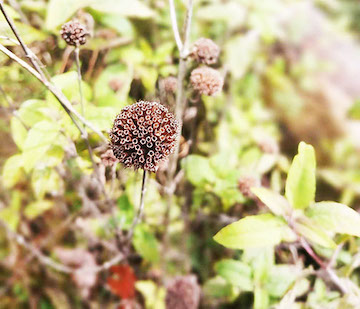Walking in Beauty
October 25, 2023
Fall comes to Brennan Woods
Crunchy, crinkly sounds underfoot; shades of brown under gray skies; breezes that chill one’s cheeks but don’t yet penetrate a sweatshirt.
Fall came to Brennan Woods slowly. Just a couple of weeks ago, I saw an Eastern comma butterfly on a warm, sunny day – its bengal orange stunning against the last green stalks of the native plants near the entrance to the preserve.
A few wilted yellow coneflower petals still hang on brittle stems and here and there is a touch of purple aster. But, for the most part, the wildflowers have dried, their seeds left for birds to eat over the winter. Some seeds will fall to the ground then a blanket of snow will push them into the earth and set the stage for next year’s blooms.
In the warmth of early fall, the echinacea, yarrow, bergamot, boneset, goldenrod and other native plantings at the Clear Lake Nature Preserve take on a skeletal grace. Dried flowers can be purchased for fall displays and wreaths, and they have the same kind of rustic glamor in the wild. They rustle in the wind, a variety of heights and dimensions.

Wild bergamot leaves behind a textured seed pod following this summer's blooms.
At first, the brown praying mantis looked like a piece of grass rubbing against a small tree protected by a wire cage on the Brennan Woods preserve. But it twitched, then spun around the wire a few times before posing patiently for a photo.
Using an ID guide provided by Indiana Nature LLC, I determined it was a native Carolina mantis, and not the larger Chinese mantis – which Indiana Nature contends should be removed from the environment to encourage a native population.
“Chinese mantises were accidentally introduced to America in 1896 through the nursery trade in Philadelphia and have subsequently been purposely released for pest control and purchased for education and even as pets,” says Indiana Nature. “Both species of mantis are predatory and opportunistic hunters, lying in wait for their prey. Both typically eat insects, spiders, isopods, and other terrestrial Arthropoda creatures, but the larger, more powerful Chinese mantises have been documented killing frogs, lizards, salamanders, shrews, mice, small turtles, bats, and even hummingbirds by stalking flowers and nectar feeders.”
Chinese mantises are now naturalized in Indiana and are not classified as invasive, however Indiana Nature suggests their presence is a detriment to declining native insects, like bees and Monarch butterflies.
Praying mantises can adapt their color to match the landscape, hence the brown mantis I encountered at Brennan Woods. Because its abdomen was long and slender, I suspect it was a male. On a cool, cloudy day, it was making the most of its time on that tree cage, despite a bent or damaged abdomen.
Did you know there are people who raise praying mantises, feeding them things like crickets and fruit flies? Online praying mantis enthusiasts’ message boards speak to a condition called abdominal collapse; there are several theories of what causes it, and the bug may recover or live for some time with the disability.
Our little mantis at Brennan Woods will eventually become another bit of brown on the ground, then it will return to the soil along with the wildflower seeds, where Mother Nature will nurture them and give birth to a new spring of diverse nature.

A praying mantis hangs out on a tree cage at Brennan Woods on a recent fall day.
